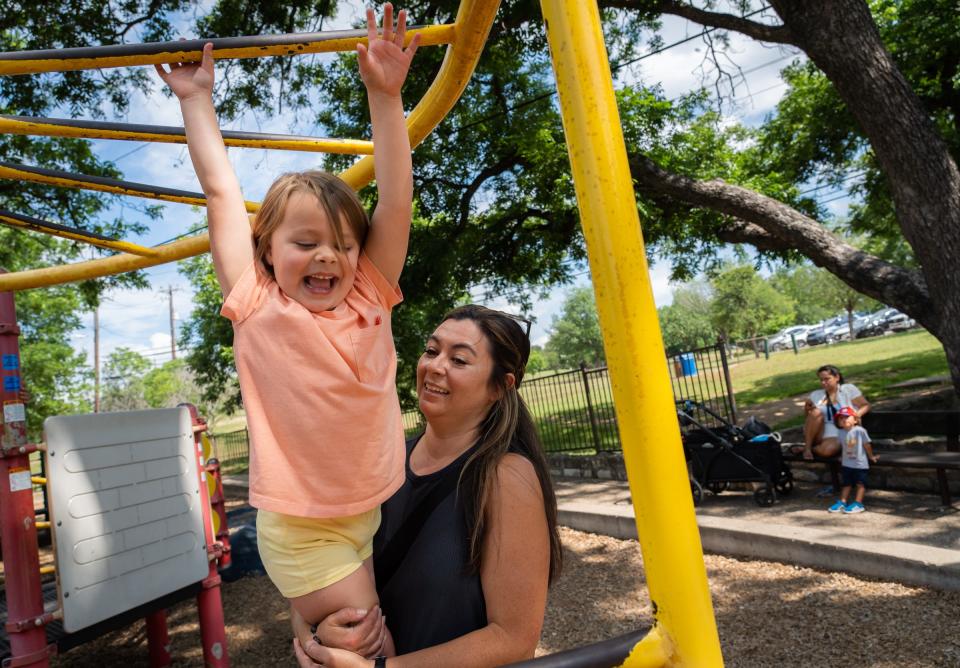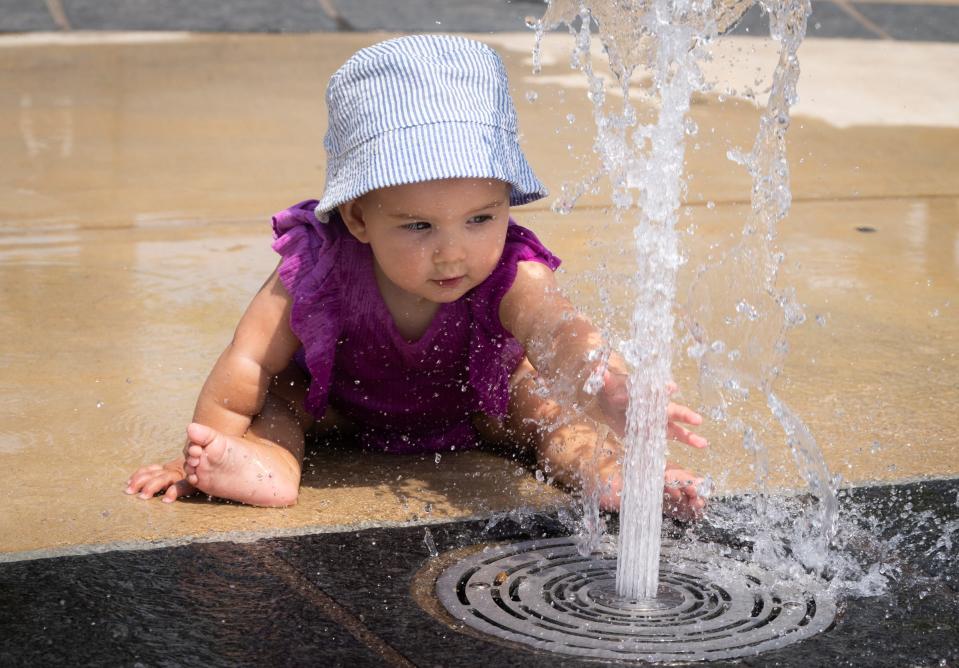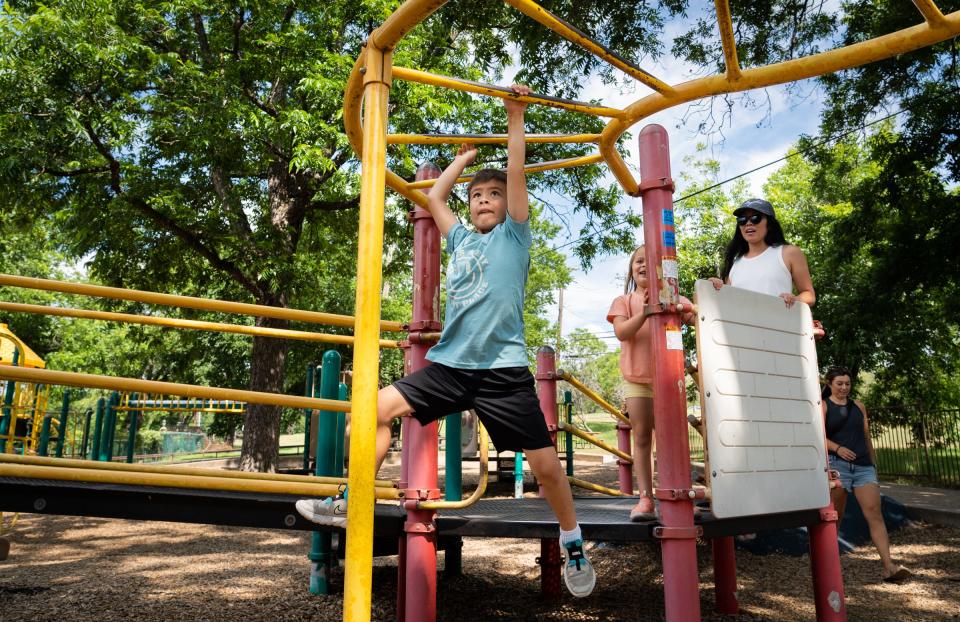UT research: Heat really does make a difference in how kids play
Kids play differently when it's hot. That might seem like a no-brainer, but the University of Texas Human Development and Family Sciences Department's researchers actually studied how kids played at different temperatures.
Researchers put wearable activity devices similar to a Fitbit, but more precise, on 47 preschoolers at Priscilla Pond Flawn Child and Family Laboratory School on the UT campus.
The researchers compared the kids' activity level with the temperatures at the school's playground. The study was done during two weeks in April 2022, when temperatures varied from 72 degrees to 95 degrees.
The kids spent less time doing moderate to vigorous physical activity at 95 degrees than at 72 degrees. At 72 degrees, 27% of the time the kids were experiencing moderate to vigorous activity. That could be achieved by running, climbing, jumping, bicycling, playing hide and seek and other games. It's being more active than just walking. At 95 degrees, the kids were only at that activity level 21% of the time.

The results of the study published in the Journal of the American Medical Association Pediatrics in March.
Kids need to be at a moderate to vigorous physically active level for at least 60 minutes a day, said Elizabeth Gershoff, a UT professor in human ecology and a supervisor of the study. That number is also recommended by the federal Centers for Disease Control and Prevention. Being active helps develop heart, muscle and bone health in kids.
Even the children at the UT Laboratory School, which offers an hour of outdoor play in the morning and an hour in the afternoon, weren't getting those 60 minutes of moderate to vigorous activity.
"Most parents assume that they are getting that at school," said Andrew Koepp, a doctoral student who led the study. "They are not getting a lot of that at home. They are not going to reach those goals."
Koepp became interested in studying kids' play and heat as both a public health matter and a climate change matter.
The Laboratory School has created an environment to make playing outside in the heat more tolerable, with its large shade structures, natural materials that don't radiate heat, big oak trees and fruit-bearing trees.
"It's pretty shady compared to a lot of space," said Amy Bryan, director of the Laboratory School. "There's a lot of running."
The school converted its traditional playground space in 2017 to an outdoor learning laboratory and made it a natural playscape with water play, shade, grassy areas, play huts, raised garden beds and more. The kids play outside every day unless it is raining heavily or a poor air quality day.
Even the researchers were surprised how much of a difference the heat made on children's level of play in an environment with good shade and water features. "Even with all these wonderful things, heat impacts kids' behavior," Gershoff said.
The researchers are now repeating the experiment at other preschool sites in Austin at different times of the year to see how the temperatures and the environment make a difference in preschoolers' activity levels.
They are hoping this research will improve funding for more natural playscapes with heat mitigation techniques, such shade structures with natural grass and mulch instead of concrete.

Safe play: Is your playground safe? Look for these things before you play
Be safe on a hot playground this summer
If you are heading out to a playground this summer, follow these safety tips:
Avoid the heat of the day. Early morning and dusk see cooler temperatures.
Wear appropriate clothing. Hats and lightweight, light-colored breathable fabrics can keep kids cooler. Use sunscreen and bug spray. Shoes meant for playing (not flip-flops) are also important.
Touch surfaces before playing. Metal, rubber and plastic products get very hot in the summer, especially under direct sun. Ensure surfaces such as slides are cool to the touch to avoid getting burned. Do let children play barefoot on the playground.
Drink water at least every 15 to 20 minutes. If you feel thirsty, you need to drink water. That’s a sign that your body is in the earliest stages of being too hot. Urine should be a light yellow color, not dark yellow or brown, an indicator of dehydration. If your child no longer needs to go to the bathroom, that's a sign of dehydration.
Look for signs of heat exhaustion: thirst, muscle cramps, feeling hot, dizzy, lightheaded, nausea or weak. Heat stroke has all these signs, plus confusion, unresponsiveness and not sweating. The body cannot regulate temperature and a child might have a fever of 104 degrees to 106 degrees. Call 911 if you see signs of heat stroke. Get the person to a cool, shady area. Put cool towels or compresses around their neck, groin area or under their armpits to lower their temperature. Try to get them to sip cool water.
Heat safety: Use hydration, common sense to protect yourself from Central Texas heat

More playground safety tips
Check the playground for safety hazards. Does the equipment look well-maintained? Any splinters, cracks or screws or metal pieces that stick out? Is there anything that could pinch, grab or trap a child? Are there handrails on elevated equipment like slides? Does the playground have soft materials such as wood chips or recycled tires underneath the playscapes?
Is the playground age-appropriate for your child? Often there are signs with an age range. A good rule of thumb: A playground should be no more than twice your child’s height.
Is your child using the equipment correctly? They should not be adding anything to hang from or be climbing atop surfaces meant as shade coverings.
Playground safety: How do kids typically break their bones in summer? Depends on their age
Don't forget to bring these things to the playground
Water for hydration. Avoid sports drinks or anything with caffeine.
A basic first-aid kit with bandages, antiseptic, insect sting cream, an EpiPen or Benadryl.
A charged cellphone and the number to your doctor’s after-hours care. Call 911 if kids become unresponsive, have trouble breathing, have blue lips, vomited, have a seizure or are incoherent.
This article originally appeared on Austin American-Statesman: University of Texas confirms kids play differently when it's hot

